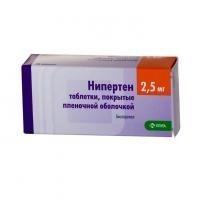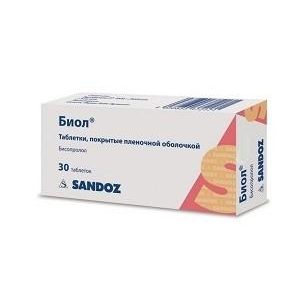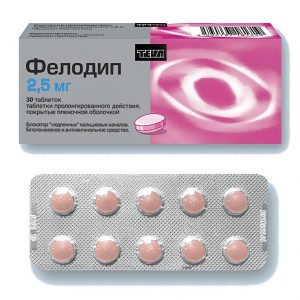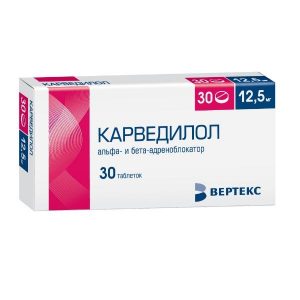Description
Release form
Film-coated tablets.
Packing
100 pcs.
Pharmacological action
Niperten has a hypotensive, antianginal, antiarrhythmic effect.
Indications
arterial hypertension
ischemic heart disease: prevention of angina pectoris attacks
CHF.
Contraindications
Hypersensitivity to Niperten components and other -adrenergic blockers
Shock (including cardiogenic)
Collapse
Pulmonary edema
Acute heart failure, stage III, chronic decompensation srpdomen Sinus node weakness
Severe bradycardia
Prinzmetal angina
Cardiomegaly (without signs of heart failure)
Arterial hypotension (SBP less than 100 mmHg, especially with myocardial infarction)
Severe forms of bronchial asthma and chronic obstructive pulmonary disease (COPD) with a history of
Concomitant use of MAO inhibitors (except MAO-B)
Late stages of peripheral circulation disturbance
Raynaud ² ¢s disease without concurrent use )
Metabolic acidosis
Age under 18 years of age (efficacy and safety not established).
Caution:
Hepatic insufficiency
Chronic renal failure
Myasthenia gravis
Thyrotoxicosis
Diabetes mellitus
AV block I degree
depression (including a history) srdlr especially with myocardial infarction)
severe forms of bronchial asthma and chronic obstructive pulmonary disease (COPD) with a history of
simultaneous administration of MAO inhibitors (except MAO-B)
late stages of peripheral circulatory disturbance
Raynaud ² ¢s disease rheumatic bladder disease )
metabolic acidosis
age 18 years (efficacy and safety not established).
Precautions: liver failure, chronic renal failure, myasthenia gravis, thyrotoxicosis, diabetes mellitus, AV block I degree, depression (including history), psoriasis, allergic reactions (history), old age. especially with myocardial infarction)
severe forms of bronchial asthma and chronic obstructive pulmonary disease (COPD) with a history of
simultaneous administration of MAO inhibitors (except MAO-B)
late stages of peripheral circulatory disturbance
Raynaud ² ¢s disease rheumatic bladder disease )
metabolic acidosis
age 18 years (efficacy and safety not established).
Precautions: liver failure, chronic renal failure, myasthenia gravis, thyrotoxicosis, diabetes mellitus, AV block I degree, depression (including history), psoriasis, allergic reactions (history), old age.
Special instructions
The condition of patients receiving Niperten should be monitored: measurement of heart rate and blood pressure (at the beginning of treatment daily, then 1 time every 3-4 months), ECG, determination of blood glucose in patients with diabetes mellitus (1 time in 4-5 months). In elderly patients, it is recommended to monitor renal function (1 time in 4-5 months). The patient should be trained in the method of calculating heart rate and instructed on the need for medical consultation with a heart rate of less than 50 beats / min.
Before starting treatment, it is recommended to study the function of external respiration in patients with a history of bronchopulmonary burden.
In approximately 20% of patients with angina pectoris, beta-blockers are ineffective. The main causes are severe coronary atherosclerosis with a low threshold for ischemia (heart rate less than 100 beats / min) and an increased final diastolic volume of the left ventricle, which violates the subendocardial blood flow.
In smokers, the effectiveness of beta-blockers is lower.
Patients using contact lenses should consider that tear fluid production may be reduced during treatment.
When using the drug in patients with pheochromocytoma, there is a risk of developing paradoxical arterial hypertension (if effective alpha-adrenoblockade is not previously achieved).
With thyrotoxicosis, bisoprolol may mask certain clinical signs of thyrotoxicosis (e.g., tachycardia). Abrupt withdrawal in patients with thyrotoxicosis is contraindicated, since symptoms may intensify.
With diabetes, it can mask tachycardia caused by hypoglycemia. Unlike non-selective beta-blockers, it practically does not enhance insulin-induced hypoglycemia and does not delay the restoration of blood glucose concentrations to normal levels.
With the simultaneous use of clonidine, its administration can be stopped only a few days after the withdrawal of the drug Niperten.
It is possible to increase the severity of the hypersensitivity reaction and the lack of effect of the usual doses of epinephrine against the background of a burdened allergic history.
If it is necessary to carry out planned surgical treatment, drug withdrawal is carried out 48 hours before the start of general anesthesia. If the patient took the drug before surgery, he should choose a drug for general anesthesia with a minimally negative inotropic effect.
Reciprocal vagus nerve activation can be eliminated iv by administration of atropine (1-2 mg).
Medicines that reduce the reserves of catecholamines (including reserpine) can enhance the effect of beta-blockers, therefore, patients receiving such combinations of drugs, requires constant monitoring by a doctor to detect a pronounced decrease in blood pressure or bradycardia.
Patients with bronchospastic diseases can be prescribed cardioselective beta-blockers in case of intolerance and / or ineffectiveness of other antihypertensive drugs. An overdose is dangerous for the development of bronchospasm.
In the case of elderly patients with increasing bradycardia (less than 50 beats / min), a marked decrease in blood pressure (systolic blood pressure below 100 mmHg), AV block, it is necessary to reduce the dose or stop treatment.
It is recommended that therapy be discontinued if depression develops.
Do not abruptly interrupt treatment because of the danger of withdrawal syndrome (severe arrhythmia and myocardial infarction). Cancellation is carried out gradually, reducing the dose for 2 weeks or more (reduce the dose by 25% in 3-4 days).
Niperten should be discontinued before examining the blood and urine levels of catecholamines, normetanephrine and vanillinindic acid, and antinuclear antibody titers.
Influence on the ability to drive vehicles and control mechanisms
The question of the possibility of engaging in potentially hazardous activities that require increased attention and speed of psychomotor reactions should be decided only after assessing the patient’s individual reaction to the drug (especially at the beginning of treatment, due to the possibility of dizziness )
Composition
1 tablet contains 2.5 mg bisoprolol fumarate.
Dosage and administration
Niperten is taken orally, on an empty stomach in the morning, without chewing, once. It is recommended to take 5 mg once. If necessary, increase the dose to 10 mg once a day. The maximum daily dose is 20 mg.
Side effects of
From the central nervous system and peripheral nervous system: fatigue, weakness, dizziness, headache, sleep disorders, depression, anxiety, confusion, or short-term memory loss, hallucinations, asthenia, myasthenia gravis, paresthesia in the extremities (in patients with “Intermittent” lameness and Raynaud’s syndrome), tremor, cramps (including calf muscles).
From the side of the organ of vision: visual impairment, decreased secretion of lacrimal fluid, dryness and soreness of the eyes, conjunctivitis.
From the cardiovascular system: sinus bradycardia, palpitations, violation of myocardial conduction, AV block (up to the development of complete transverse blockade and cardiac arrest), arrhythmias, weakening of myocardial contractility, development (aggravation) of heart failure (swelling of the ankles, feet shortness of breath), decreased blood pressure, orthostatic hypotension, manifestation of angiospasm (increased impaired peripheral circulation , cold extremities, Raynaud’s syndrome), chest pain.
From the digestive system: dry oral mucosa, nausea, vomiting, abdominal pain, constipation or diarrhea, impaired liver function (dark urine, yellowness of the sclera or skin, cholestasis), taste changes.
From the respiratory system: nasal congestion, difficulty breathing when prescribed in high doses (loss of selectivity) and / or in predisposed patients – laryngo- and bronchospasm.
From the endocrine system: hyperglycemia (in patients with non-insulin-dependent diabetes), hypoglycemia (in patients receiving insulin), hypothyroid state.
Allergic reactions: pruritus, rash, urticaria.
From the skin: increased sweating, flushing of the skin, exanthema, psoriasis-like skin reactions, exacerbation of the symptoms of psoriasis, alopecia.
Laboratory parameters: thrombocytopenia (unusual bleeding and hemorrhage), agranulocytosis, leukopenia, changes in liver enzyme activity (increased ALT, ACT, bilirubin, triglycerides.
Effect on the fetus: intrauterine growth retardation, hypoglycemia, s bradycardia. , arthralgia, decreased libido, decreased potency, withdrawal syndrome (increased angina attacks, increased blood pressure).
Drug Interactions
Allergens used for immunotherapy or allergen extracts for skin tests increase the risk of severe systemic allergic reactions or anaphylaxis in patients receiving bisoprolol.
Iodine-containing radiopaque agents for iv administration increase the risk of anaphylactic reactions.
Phenytoin with iv administration, funds for inhalation anesthesia (hydrocarbon derivatives) increase the severity of the cardio-depressant effect of bisoprolol and the likelihood of a decrease in blood pressure.
Niperten changes the effectiveness of insulin and hypoglycemic agents for oral administration, masks the symptoms of developing hypoglycemia (tachycardia, increased blood pressure).
Bisoprolol reduces the clearance of lidocaine and xanthines (except theophylline) and increases their concentration in blood plasma, especially in patients with initially increased clearance of theophylline under the influence of smoking.
Antihypertensive effect is weakened by NSAIDs (sodium ion retention and prostaglandin synthesis blockade by the kidneys), corticosteroids and estrogens (sodium ion retention).
Cardiac glycosides, methyldopa, reserpine and guanfacine, slow calcium channel blockers (verapamil, diltiazem), amiodarone and other antiarrhythmic drugs increase the risk of developing or worsening bradycardia, AV blockade, heart failure and heart failure.
Nifedipine can lead to a significant decrease in blood pressure.
Diuretics, clonidine, sympatholytics, hydralazine and other antihypertensive drugs can lead to an excessive decrease in blood pressure.
Extends the action of non-depolarizing muscle relaxants and increases the anticoagulant effect of coumarins.
Tri- and tetracyclic antidepressants, antipsychotics (antipsychotics), ethanol, sedative and hypnotic drugs increase CNS depression.
The simultaneous use with MAO inhibitors is not recommended, due to a significant increase in the hypotensive effect, the treatment interval between taking MAO inhibitors and bisoprolol should be at least 14 days.
Non-hydrogenated ergot alkaloids increase the risk of peripheral circulation disorders.
Ergotamine increases the risk of developing peripheral circulatory disorders sulfasalazine increases the concentration of bisoprolol in blood plasma rifampicin reduces.
Overdose
Symptoms: arrhythmia, ventricular extrasystole, severe bradycardia, AV block, marked decrease in blood pressure, chronic heart failure, cyanosis of fingernails or palms of the fingers, difficulty breathing, bronchospasm, dizziness, fainting, convulsions.
Treatment: gastric lavage and administration of absorbent agents. Symptomatic therapy: with developed AV blockade – in / in the introduction of 1-2 mg of atropine, epinephrine or temporary setting of a pacemaker with ventricular extrasystole – lidocaine (class IA drugs are not used) with a decrease in blood pressure – the patient should be in the Trendelenburg position if there are no signs of pulmonary edema – iv plasma-replacing solutions, with inefficiency – epinephrine, dopamine, dobutamine ( to maintain chronotropic and inotropic effects and eliminate a pronounced decrease in blood pressure) in heart failure – cardiac glycosides, diuretics, glucagon in convulsions – iv diazepam with b Ronchospasm – inhaled beta2-adrenostimulants.
Storage Conditions
In a dark place at a temperature not exceeding 25 ° C.
Active ingredient
Bisoprolol
Terms
pharmacy leave with prescription
Form of Treatment
tablets
KRKA d.d. Novo mesto AO, Slovenia




